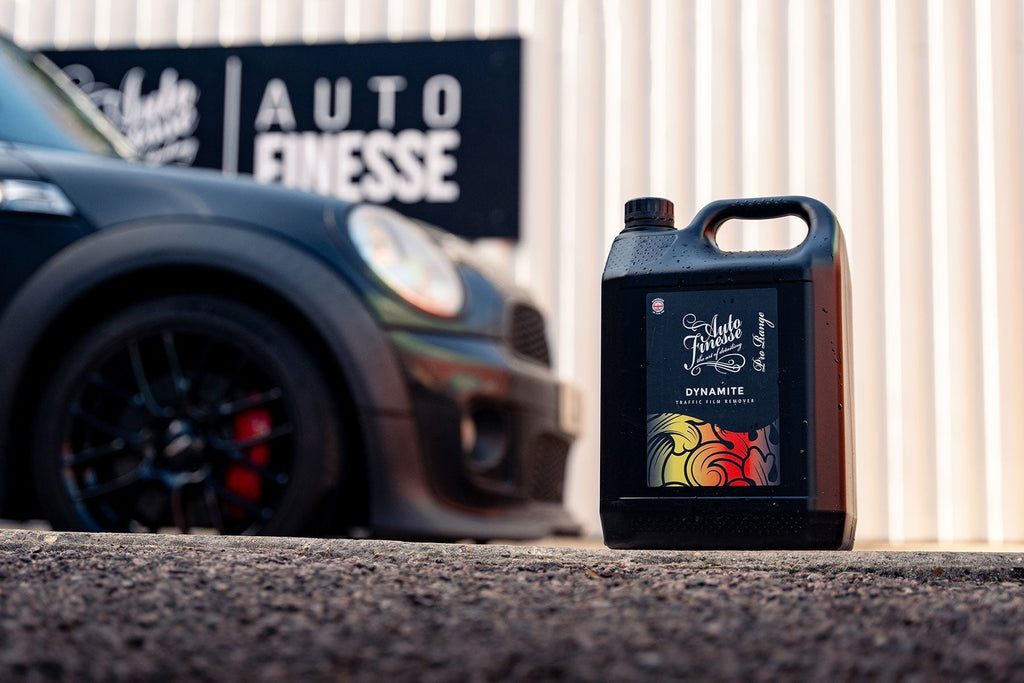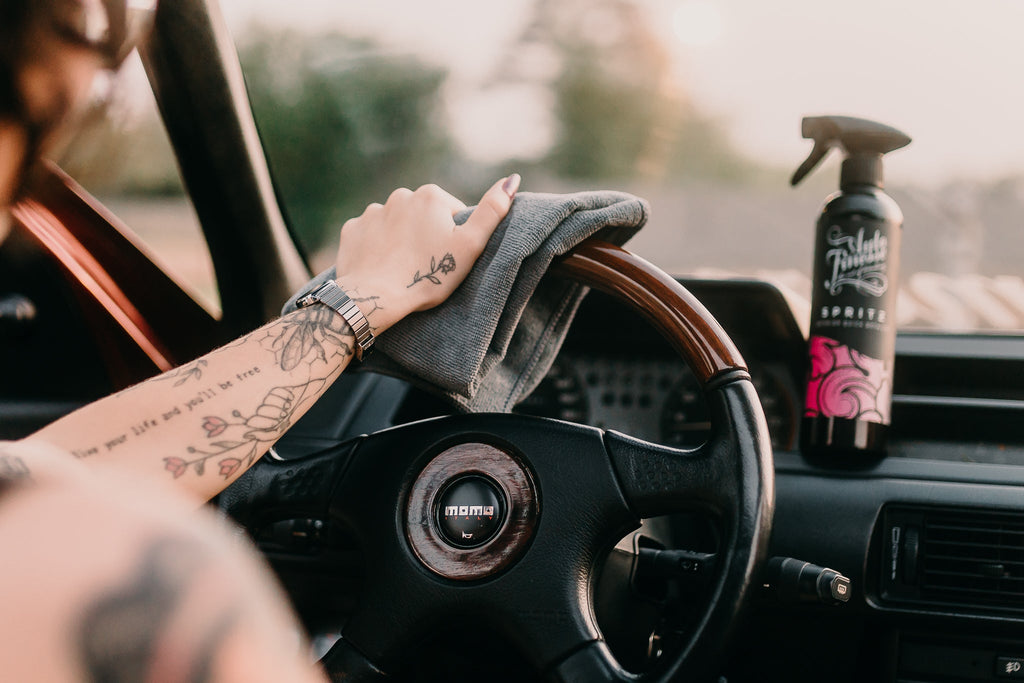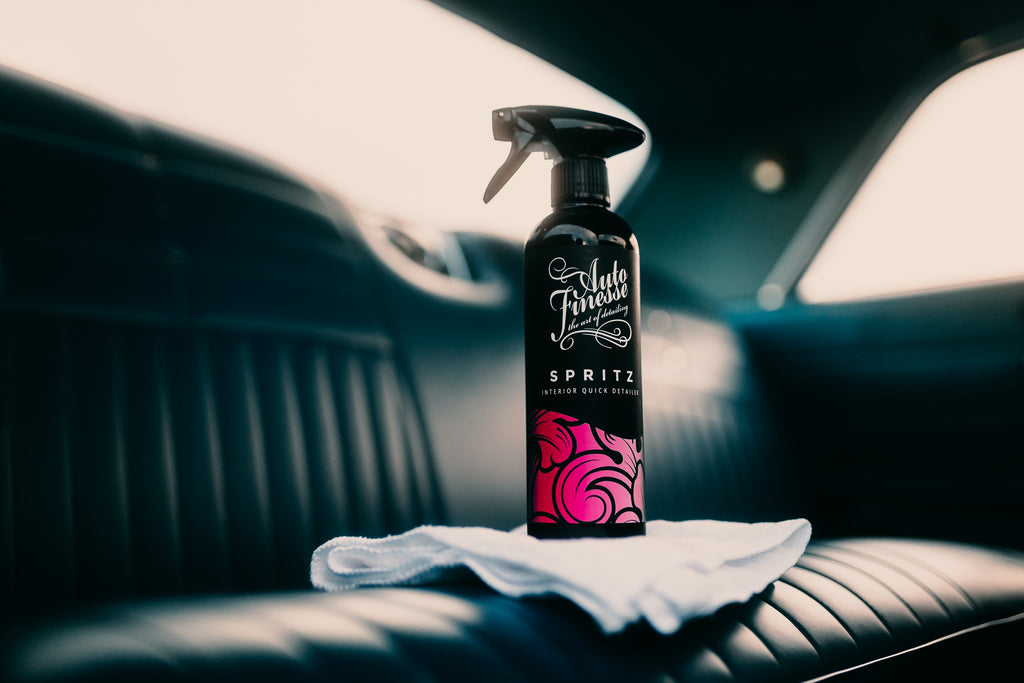The Many Uses Of Dynamite Traffic Film Remover

IN THIS GUIDE:
- Learn how Dynamite works to safely eradicate grease and grime on a molecular level.
- Discover a range of specific detailing tasks where Dynamite can push your detail to the next level.
- Learn the best dilution ratios to tackle any concentration of soiling on different parts of your car.
- See why using Dynamite during your car wash is essential all-year-round.
Let’s take a closer look at our versatile, dilute-to-suit pre-wash…
Different areas of your car will suffer from exposure different types of contamination and, perhaps even more importantly, in different concentrations. It’s the reason why professional detailers employ a surface-safe pre-wash before their contact wash, and even before that, they start their detail by cleaning the underside, engine bay and wheels.
The aim of any professional car wash is to prevent cross contamination and achieve swirl-free results by limiting the risk of damage to sensitive surfaces. It’s also the reason why specialist detailing products such as pre-cleaners, wheel cleaners, snow foam and car shampoos have to be used at the correct stage of your detail to get the best professional results.
Dynamite Traffic Film Remover is one of these cleaning agents used for specialist tasks. The difference is the versatility and the amount of different tasks this powerful, dilute-to-suit cleaner can perform safely and effectively.
Let’s take a look at why you need this detailing essential all-year-round…








This concentrated TFR, is a safe citrus pre-wash solution developed to breakdown dirt and road grime from all vehicle ex... See product details More

What is Dynamite Traffic Film Remover?
Dynamite is a powerful surfactant-based cleaning agent designed to break away, lift and encapsulate grime, allowing it to be removed safely and, most importantly, without damaging what’s underneath.
Developed as a surface-safe, citrus-infused cleaner to be used in the pre-wash stage, the main purpose of Dynamite is to safely rid your car of the kind of harmful contamination – chiefly gritty grime particles and bonded contaminants – that may scratch surfaces if dragged across them with your mitt during your contact wash.
This pre-wash process itself is designed to be completely contactless and that’s where using a powerful pre-cleaner like Dynamite is crucial to get the best results with minimal effort. Essentially you spray on a suitable dilution of solution (for the level of soiling to be removed), allow it to dwell while it encapsulates the grime, and then rinse away the solution and grime together.
This crucial detailing step is carried out over the whole vehicle before you contact wash, which is why Dynamite has been developed to be safe for use on all types of surfaces, from paintwork and vinyl wraps, to glass, rubber, plastics and wheels. This makes it easy to use every time you wash your car. And if you’re worried about stripping away any previously applied protection layers during your routine maintenance washes, rest assured that this formula won’t affect them either. Dynamite has been specifically designed to be wax, sealant and coating-safe.
But, while this product is technically classed as a pre-wash (or pre-cleaner) for the safest contactless pre-wash stage, it can be used to clean other areas with a little light contact. This agitation process isn’t about mechanical cleaning, or physically scrubbing, away grime it’s simply a way of making the most of your solution and making sure it reaches the most awkward areas. But we’ll get to that.
The fact that this product is suppled as an ultra-concentrated solution that can be diluted to different ratios opens up a whole new world of cleaning ability, and it’s what makes Dynamite extremely versatile for performing a number of other cleaning tasks on different parts of your car.





Why does Dynamite need to be diluted?
It’s not just about saving you money, which ultimately it does. Diluting your Dynamite concentrate with water should always be directly proportional to the amount of soiling you’re looking to remove.
Like all kinds of cleaning agents there’s only so grime much that a specific volume of the cleaner itself can encapsulate before it’s ‘spent’, or essentially full up with contamination. This means that a dirtier area with a higher concentration of grime particles requires more cleaning agent in the solution to safely remove the most harmful contamination. Conversely of course, lighter grime doesn’t require quite so much of the cleaner. And we all know that the less you need, the more cost effective it is. Just one litre of Dynamite can make up to 10-litres of powerful cleaning solution.
If we take a pre-wash stage as an example; an absolutely filthy car may require a stronger solution like 1:6. While for routine maintenance, particularly on a car that’s previously been detailed and protected, a 1:10 solution will contain plenty of cleaning agent to do the job safely and effectively.
On other areas, say if you’re cleaning heavily soiled wheels or an oily engine bay, a little agitation with a scratch-free Detailing Brush helps to make the most the solution’s cleaning power. As we said, it’s not that you’re physically scrubbing the surface when you agitate. It’s simply that you’re moving away any spent solution and replacing it with fresh solution to work on any remaining grime. When you agitate Dynamite you’re also making sure the solution makes physical contact with any small recesses and nooks. If your cleaner can’t physically reach the area, it can’t clean it, right?
But while the science may be a little complicated, actually diluting Dynamite for the job in hand is easy. Especially if you’re using our Pro Mixing Bottle or Foaming Pressure Sprayer, which are both marked in increments to help with accurate dilution. Simply pour in the amount of concentrate you need, top up with fresh water, and that’s about it. A 1:2 solution is 1 part concentrate to 2 parts water, 1:6 is one part Dynamite to 6 parts water, and so on.



How does Dynamite deep-clean surfaces safely?
Again, it’s all in the science. Dynamite is what’s known as an aqueous cleaning agent. This means that it combines water with special surfactants and degreasers to physically pull grime from surfaces, break them down, and surround them in the solution. This keeps them away from the surface itself for safe wiping or rinsing.
We use a special blend of surfactants in Dynamite including both non-ionic surfactants, which give a degreasing action, and anionic surfactants which are used to break away particulate soiling.
On a microscopic scale surfactants are what’s known as polar molecules. You can imagine these as like a tiny tadpole where the head is attracted to water, and the tail is attracted to the grime. When your surfactant comes into contact with grime on the surface the tail part locks on and - because the head is attracted to the water part of the solution - the surfactant pulls the dirt off of the surface and into the solution itself. Once the grime particle is there floating around in the solution millions of surfactant molecules surround it, so it can’t return to the surface. This is what happens when a cleaner encapsulates grime, it simply suspends it in the solution.
The degreasing surfactants work on different types of contamination. These are used to break down large fatty molecules into smaller fatty molecules. Only when these are small enough can the other surfactants surround them. In both cases this is how the surfactants can break down the contamination, and allow it to be safely rinsed (or wiped) away.
And that’s the science but what’s most important to remember is that both the water and the surfactants work in unison - you can’t clean effectively using with one without the other. It’s also the reason why you should never let any aqueous cleaning agent dry out on your car. Whether it’s Dynamite, Verso All Purpose Cleaner, Citrus Power Bug & Grime Remover, Total Interior Cleaner, Lather Car Shampoo or many others they all require the water part of the solution to do their job. When the water is allowed to evaporate off, essentially all you’re leaving behind is the grime and the surfactants. In some cases, this can even stain surfaces, so that’s why we always keep cleaning agents wet.

When should I use Dynamite during my detail?
Dynamite has many uses in different dilutions, here’s a few top tips from our team of pro detailers…

Contactless Pre-wash (1:6 -1:10)
First and foremost, Dynamite was designed as the ultimate dilute-to-suit pre-cleaner, so that’s where we’ll start.
The thing about your pre-wash is it’s essential, no matter how clean the car appears to be. Even the tiniest particles that are almost invisible will scratch and inflict swirl marks when dragged across surfaces, and that’s why you should never go straight into a contact wash.
There’s also a misconception that such a powerful solution is only for use on dirty cars during the winter. We’ve even heard people say that Dynamite is a winter product. And while it certainly is a winter product, it’s a summer product, too.
During the hot months we may not have quite the concentration of traffic films and corrosive salt on the road, but the abundance of bugs splattering all over your paintwork are just as damaging to paintwork. Bugs tend to eat acidic substances like fruit. In fact, bugs contain more acid to etch into your paintwork than you might imagine. Of course, birds tend to poop all year-round, too. This is why a pre-wash is essential to remove contamination safely.
As for the dilution needed, that’s the beauty of Dynamite, up to 1:6 is great for filthy cars and vans with serious contamination, and 1:10 will be powerful enough to tackle lighter grime on protected vehicles. Simply apply, leave to dwell for a few minutes and rinse.






Wheel Cleaning (1:2)
The correct dilution of Dynamite makes for a powerful wheel cleaner, and it won’t even strip your wheel waxes, sealants or ceramic coatings.
Alloy wheels are subjected to prolonged exposure to some of the most harmful contamination on the roads. This includes salt, brake dust and the heaviest grime - all of which a 1:2 dilution of Dynamite can shift quickly and safely.
To ensure that your solution is making contact with every part of the wheel here, a little light agitation is important. And again, this will make the most of your cleaner by refreshing any spent solution when needed.
Working on one wheel at a time, first rinse down the entire wheel to remove any loose grime. This pre-rinse ensures that the Dynamite gets to work where it’s most needed, on the bonded grime. After applying your solution liberally to you can tackle the inner barrels with a suitable brush, here we’re using a Microfibre Wheel Brush but you can also use a Barrel Brush or Wonder Wool Wheel Brush, depending on the finish and design of your wheel.
Finally we can take on any awkward recesses and behind the spokes with a Plush Wheel Mitt, before finishing up with a Detailing Brush for the finer details such as the edges and nut recesses. After a thorough rinse the wheel is complete, and we can move onto the next one.







Engine Bay Cleaning (1:2 – 1:1)
The degreasing action of all those special non-ionic surfactants really comes into its own when cleaning oily engine bays. A 1:1, or a ‘half-and-half’, solution is extremely effective at shifting greasy stains here, and it’s easy to see the product powering through the heavy grime. What’s also great is that Dynamite is safe for use on every material found under your bonnet… and the underside of the bonnet itself.
Cleaning engine modern bays is extremely straightforward, chief because the vital stuff is protected by all sorts of plastic covers. We always start on the underside of the bonnet and work our way down into the bay piece by piece. The most important thing to remember is to mist your pressure washer over the area instead of poking it right in there. And always avoid and components like open air filters and alternators.
Other than that, it’s just a case of applying your Dynamite liberally, agitating with a suitable Detailing Brush and rinsing away the contamination. If you're using our Pressure Sprayer to apply your solution, you can also utilise the foaming nozzle to whip up the solution into a foamy consistency that lingers before brushing in, a great tip for maximum coverage.
For a more targeted approach on vintage bays and modified engines, you can follow the same process and use a microfibre Work Cloth to wipe away the residue.







Door Jambs, Boot Shuts & Fuel Flaps (1:5-1:3)
There’s no doubt that these areas are often forgotten during details, so it’s somewhat ironic that Dynamite can tackle these extremely quickly with hardly any effort of all.
First dilute your Dynamite according to the level of soiling - 1:3 will be enough to deep-clean and degrease the grimiest areas including those suffering from fuel staining. In most cases targeted cleaning is the best route, so apply your solution directly to a Detailing Brush or a super-soft Feather Tip Detailing Brush and work lightly into the entire area. Then rinse or wipe away the grime with a Microfibre Work Cloth.

Underside Cleaning (1:1)
In many cases your inner arches, the underside and suspension components be the dirtiest part of any vehicle – which makes sense, it’s the one that’s hardest to clean and suffers from the most exposure to heavy corrosive grime and road salt.
When cleaning these areas, a strong dilution is your best route, and unlike anywhere else on your car, these hidden components also benefit from a little mechanically cleaning. Scrubbing with a stiff brush like our Rubber Scrubber Tyre Brush, or a long-bristle brush like our Arch Blaster Arch Brush, serves to actively draw out grime even from under the surface. In most cases (excluding painted or powdercoated brakes where you’ll need to use a Detailing Brush and some care) you’re not going to harm mechanical components or plastic arch liners with some vigorous scrubbing. Apply your solution liberally, scrub and rinse or wipe. Easy.







Dynamite Traffic Film Remover is available in 1-litre and 5-litre bottles and ideal for use with our Pro Mixing Bottle and Foaming Pressure Sprayer.
For more top detailing guides and product spotlights check out the Guides Section Of Our Blog.








This concentrated TFR, is a safe citrus pre-wash solution developed to breakdown dirt and road grime from all vehicle exterior surfaces. From paintwork to wheel... See product details More






































